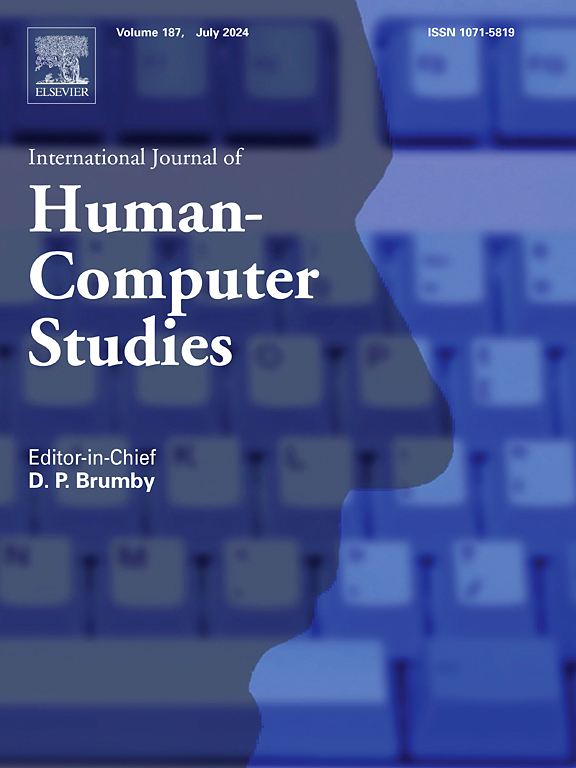Algorithmic transparency in path planning: A visual approach to enhancing human understanding
IF 5.1
2区 计算机科学
Q1 COMPUTER SCIENCE, CYBERNETICS
International Journal of Human-Computer Studies
Pub Date : 2025-06-30
DOI:10.1016/j.ijhcs.2025.103573
引用次数: 0
Abstract
Computer algorithms facilitate increased automation in various human-centered work areas to improve operational safety and efficiency. Algorithmic transparency is considered essential for human operators, policy makers and system developers, as it allows them to understand the capabilities and limitations of an algorithm. In this research, we focus on path-planning algorithms and propose a purely visual approach to achieve their transparency. This approach extracts and portrays information directly from the algorithms, aiming to visually reveal their inner workings. Benchmark tests indicate that extracting information from path-planning algorithms may significantly slow them down. For time-constrained operations, it is recommended to store only the necessary data during the pathfinding process and perform information extraction afterwards. Based on theories from cognitive engineering, six transparency levels were designed to chunk meaningful information pertaining path-planning algorithms. A user study among non-experts () was then conducted to evaluate the impact of visual algorithmic transparency on human understanding. The results suggest that increased transparency levels allow non-experts to more correctly and confidently understand the details of a path-planning algorithm. However, it is also found that certain transparency levels can lead to confusion, especially when the algorithm behaves in a way contrary to human expectations. This study further reveals that, given the same level of transparency, sampling-based algorithms may be easier to comprehend than graph-based algorithms. This research can serve as a reference for how to achieve transparency in path-planning-related applications and how to hierarchically portray and organize transparency information.
路径规划中的算法透明性:一种增强人类理解的可视化方法
计算机算法促进了各种以人为中心的工作领域的自动化,以提高操作安全性和效率。算法透明度被认为对人类操作员、政策制定者和系统开发人员至关重要,因为它使他们能够了解算法的能力和局限性。在本研究中,我们专注于路径规划算法,并提出了一种纯视觉的方法来实现它们的透明度。这种方法直接从算法中提取和描绘信息,旨在直观地揭示其内部工作原理。基准测试表明,从路径规划算法中提取信息可能会显著降低它们的速度。对于时间限制的操作,建议在寻路过程中只存储必要的数据,之后再进行信息提取。基于认知工程的理论,设计了六个透明度级别来分组有关路径规划算法的有意义的信息。然后进行了一项非专家用户研究(N=40),以评估视觉算法透明度对人类理解的影响。结果表明,提高透明度水平可以让非专家更正确、更自信地理解路径规划算法的细节。然而,研究也发现,某些透明度水平可能会导致混淆,尤其是当算法的行为方式与人类的期望相反时。这项研究进一步表明,在相同透明度的情况下,基于抽样的算法可能比基于图的算法更容易理解。该研究可为路径规划相关应用中如何实现透明度以及如何分层描绘和组织透明度信息提供参考。
本文章由计算机程序翻译,如有差异,请以英文原文为准。
求助全文
约1分钟内获得全文
求助全文
来源期刊

International Journal of Human-Computer Studies
工程技术-计算机:控制论
CiteScore
11.50
自引率
5.60%
发文量
108
审稿时长
3 months
期刊介绍:
The International Journal of Human-Computer Studies publishes original research over the whole spectrum of work relevant to the theory and practice of innovative interactive systems. The journal is inherently interdisciplinary, covering research in computing, artificial intelligence, psychology, linguistics, communication, design, engineering, and social organization, which is relevant to the design, analysis, evaluation and application of innovative interactive systems. Papers at the boundaries of these disciplines are especially welcome, as it is our view that interdisciplinary approaches are needed for producing theoretical insights in this complex area and for effective deployment of innovative technologies in concrete user communities.
Research areas relevant to the journal include, but are not limited to:
• Innovative interaction techniques
• Multimodal interaction
• Speech interaction
• Graphic interaction
• Natural language interaction
• Interaction in mobile and embedded systems
• Interface design and evaluation methodologies
• Design and evaluation of innovative interactive systems
• User interface prototyping and management systems
• Ubiquitous computing
• Wearable computers
• Pervasive computing
• Affective computing
• Empirical studies of user behaviour
• Empirical studies of programming and software engineering
• Computer supported cooperative work
• Computer mediated communication
• Virtual reality
• Mixed and augmented Reality
• Intelligent user interfaces
• Presence
...
 求助内容:
求助内容: 应助结果提醒方式:
应助结果提醒方式:


